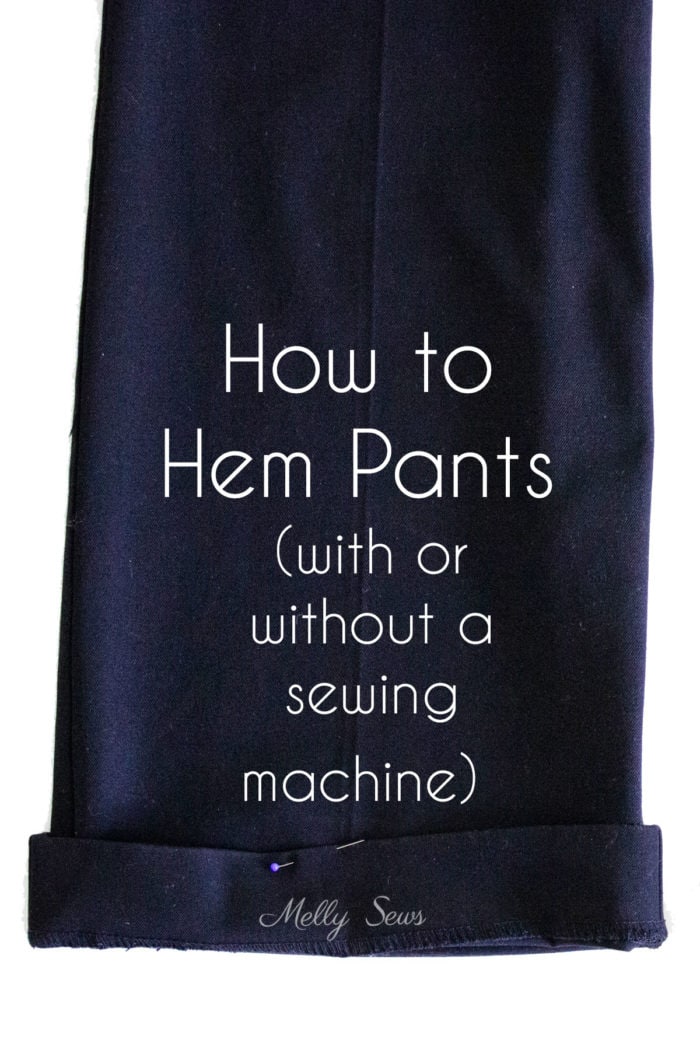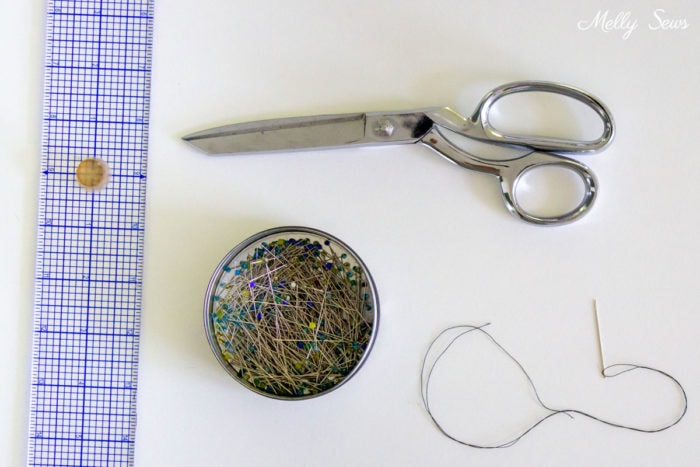Learn how to hem pants at home, by hand stitching or using a sewing machine.

Hey y’all, today I’m going to show you how to hem pants with either hand stitching or using a sewing machine. I won’t be sharing any no-sew methods of hemming, because we want these hems to last and not ruin your clothes for the future. With a few supplies that cost less than a trip to the tailor, you can have a new hem that is the correct length for your pair of pants. And the bonus is that once you know how to do this you won’t ever have to beg or pay someone else to sew a new hemline for you.
It seems like around this time of year every year I get requests for pants hemming. I think it has to do with all the proms and graduations and weddings this time of year. And while I won’t hem your pants for you unless you’re in my Favorites contacts on my phone, I will share with you how to hem your own trousers. And if you already know how to hem pants, this post is perfect to send to people who come out of the woodwork asking you to hem their clothes.
Note that this post is not about hemming jeans. Though jeans are pants, they are generally hemmed differently than dress pants with a straight stitch on the machine. I have another tutorial with video to hem jeans here.
Supplies for Hemming Pants
Pictured below are the minimum supplies you need to hem shorts or pants (because the technique is the same for both).

To shorten your pants (or lengthen your trousers) you’ll need:
- All purpose thread that matches your pants
- A hand sewing needle
- Scissors
- A ruler or measuring tape of some sort, even if it’s just one you print from the internet or a screenshot on your phone.
- Pins. You can either use straight pins (handy for general sewing) or safety pins, but you need something to hold the hem after you cuff the legs to the right length and take the pants off.
- An iron. In a pinch try a flat iron or curling iron for hair.
- Optional: some kind of marking tool to help mark your new hems. In a pinch, even a pen or pencil can work as long as it will wash out and you only mark on the wrong side of the fabric.
- Optional: a seam ripper. You can use scissors to unpick existing hems instead, but a seam ripper might make things easier.
This post contains affiliate links. As an Amazon Associate I earn from qualifying purchases. All affiliate links are identified with (affiliate link) after the link or a commissions earned statement above the link(s).
If you don’t have any of the supplies, you can buy this kit (affiliate link) with all of the essentials. And in fact, that would also make a good graduation gift for anyone going off to college.
How to hem your own trousers
I’ve made a very thorough video tutorial for how to hem your pants without a sewing machine that you can watch below or on YouTube here. If you do have a sewing machine, watch the beginning of this video to see how to mark and cut your pants. Then scroll further down in the post to see how to use a sewing machine to sew a blind hem stitch.
Mark Your Hems
The first step is to try the trousers on, fold them up to the desired length, and pin that length in place. Wear the pair of shoes or heels you intend to wear with the pants when you’re folding your hem.
If your pants are too short and you need to let them down before hemming, start by unpicking the current hem with a seam ripper or scissors. Then press the bottom of the pants with an iron to get rid of the crease from the original hem. You can start with that step if you’re shortening the pants too. Depending on how much shorter you need the pants to be you might be able to cut off the existing hems without having to unpick them.
It helps to look at your pants in front of a full-length mirror after they’re pinned to check your work.
Take the pants off. Measure the amount you folded up.
Turn your pants inside out. Mark the finished length, then measure down at least 1 1/4 inch up to 2 1/4 inches below the mark. Pants hems are generally 1 to 2 inches, and you need an extra 1/4 inch more than your finished hem length to fold under to prevent fraying. Cut off any excess fabric below this lower mark.
Press the bottom edge of fabric up 1/4 inch to the wrong side. Then fold again and press up the amount of your finished hem width. So, for example, if you want 1 inch finished hems you’d leave 1 1/4 inches below your desired final length, then press up 1/4 of an inch, then press up again 1 inch. The video above shows this more clearly. Pin.
Hand Hemming
Thread your needle and knot the end of the thread. Now we’re ready to sew. Poke your needle up through the cuff from between the pants and the fold and pull the thread through; the knot should be hidden between the pants and the folded edge. Now move the needle over about 1/2 inch. Holding the needle perpendicular to the pants let, poke it down through the folded edge and into the pants. Catch just a few threads of the pant leg on your needle and poke it back onto the wrong side. Pull the thread through. This is the first stitch.
Repeat this stitch every half an inch or so around the pants leg until you get back to where you started. You’ll see Then sew up through the folded edge only in the same place twice. On the second stitch, stop before you pull the thread loop all the way to the fabric. Instead, wind your needle through the thread loop 3 to 4 times, then pull it all the way tight to knot it. Cut the thread.
Sewing Machine Hemming
To use a sewing machine to hem your pants, fold, measure, mark and cut your pants as described above. Then watch the video below or on YouTube here to see how to hem pants with a sewing machine. I also have a blind hem picture tutorial in this post.
As you can see, the blind hem stitch on a sewing machine combines a zig zag stitch with a straight stitch to replicate the look of a hand sewn hem.
So, if you, like me, dislike hemming pants for others, bookmark this article. That way you can send the link to the next person who asks you to hem.

Frances Cloughley
Ok thank you for the clear instructions in the clip
Brenda Jerles
I actually don’t mind hemming pants. I have been hemming my own since I was 14. I always hemmed my jeans by hand back then. I am one of those unusual people that enjoys the hand sewing. I also like to bind quilts by hand.